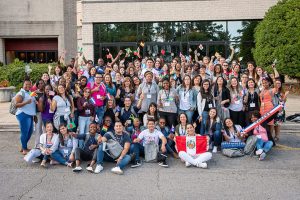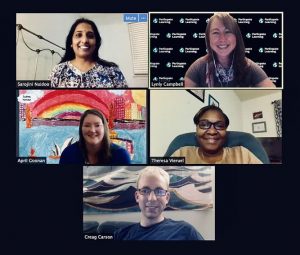The 2020-21 school year is unlike any other, as teachers, professors, and educators of all types have asked themselves, “How can I adapt what I was doing so effectively in person to a new, virtual teaching environment?” As an instructional coach at Participate Learning, I have had the pleasure of observing the multitude of ways that our international teachers have risen to this daunting challenge, creating supportive and positive online spaces for students to grow.
Making the shift to virtual training
What our international teachers may not know is that the teacher resources team at Participate Learning was faced with the same dilemma when planning our biggest training event of the year—orientation for new ambassador teachers. Most ambassador teachers will fondly remember their orientation experiences, where they met other educators from around the world and learned so much about life, logistics, and teaching in the U.S. It was likely an overwhelming week filled with anticipation of the adventure that was about to unfold.

Reenvisioning orientation as a fully virtual experience was no easy task. We asked ourselves, “How can we create genuine connections among teachers online?” “How can we assess the levels to which teachers have absorbed the training when they aren’t physically present?” After some training and tips from our sister company, Participate Inc., our team set out to tackle these challenges. Our goal was always to create a helpful, meaningful online training experience that honored teachers’ previous teaching backgrounds while introducing new ideas in dynamic and engaging ways.
Creating courses and building connections
We very quickly realized that creating online courses is not the same as posting a slide deck from an in-person training event and asking multiple-choice questions to assess understanding. That wouldn’t be effective at all! Instead, we used a backward design approach, planning our content around what the learners should be able to do at the end of each course (create effective lesson plans for their new classes in the U.S.). To ensure that the content was presented in a clear and comprehensible way, our team created videos and visuals. Some of the videos featured current ambassador teachers with Participate Learning and the work they are doing in their classrooms at our partner schools.

To foster connections among teachers going through orientation, virtual social events are hosted by the Participate Learning team, and teachers are encouraged to post in discussion threads. In order to assess understanding and offer feedback, as well as a chance for the teachers to ask questions about their coursework, the instructional team and I host virtual instructional live sessions. Teachers submit their coursework to us, and we provide feedback and award credentials for successful completion on Participate Inc.’s virtual platform.
Lessons learned
What have I learned throughout this process? First, I feel that I’ve upended a personal misconception that online training is less effective than in-person training. When executed well, I can now see that adults can take their learning to an even deeper level through online courses. This approach also makes it easier for teachers to reference their training materials once they’re settled in their U.S. classrooms—online access allows them to reference materials at their convenience. From an instructor’s perspective, online courses allow us to review the work of each teacher, and get to know them better than we necessarily would in person (it’s tough to make personal connections with everyone when training in a conference room of 100 people!).
Like many aspects of teaching in 2020, reenvisioning orientation has been a challenge. However, it’s pushed us to expand the boundaries of what we thought we were capable of. Although orientation may not be fully online in the future, this experience has had a permanent impact on our training methods. It seems clear that we will continue to use online courses and a hybrid approach to ensure that teachers arrive in the U.S. prepared for instruction.
Participate Learning is a force for good that connects teachers and students through comprehensive programs to foster human understanding and create peace around the world. Our mission to unite our world through global learning would not be possible without the dedication and hard work of our ambassador teachers. To learn more about how we support our ambassador teachers throughout their entire journeys, check out this webpage, or contact us directly for more information.




